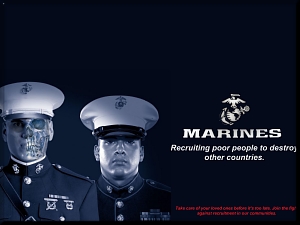From Draft NOtices, April-June 2012
— Rodrigo de la Rosa
 The Latino/a population enlisted in the United States military is rapidly increasing and is projected to be as much as 22.3% of the armed forces by 2020. Without a doubt as the population of Latinos and Latinas increases in the U.S. the amount of Latino/Latina military personnel will do so as well. The Pew Hispanic Center estimates that in 2001 there were 109,487 enlisted soldiers who classified themselves as Hispanics, with 14% of them enlisted in the Marine Corps.
The Latino/a population enlisted in the United States military is rapidly increasing and is projected to be as much as 22.3% of the armed forces by 2020. Without a doubt as the population of Latinos and Latinas increases in the U.S. the amount of Latino/Latina military personnel will do so as well. The Pew Hispanic Center estimates that in 2001 there were 109,487 enlisted soldiers who classified themselves as Hispanics, with 14% of them enlisted in the Marine Corps.
The Pew Hispanic Center published statistics that exposed the risk Hispanics take when enlisting in the military. From 2001 to 2009, during Operation Iraqi Freedom and Operation Enduring Freedom, the death toll of Hispanic military personnel was 450, all of whom had family members, loved ones and people who cared for them. It is very important to remember that when these individuals pass away, it has a significant impact on the people to whom they were connected back home. The majority of our Latino/Latina or Hispanic brothers and sisters have been used as cannon fodder by the U.S. military. Despite the fact that they are aggressively recruited by the military, only a miniscule number of them have high-ranking positions as officers.
It is also important to realize and recognize that the Latino/Latina population has been fighting in U.S. wars for more than 150 years. They have fought in the Civil War, World War I, World War II, the Korean War, and the Vietnam War. They have played a crucial role in the development of what the U.S. is today, whether it be good or bad. Because few people are aware of these facts, a monument memorializing these soldiers will be erected in historic Chicano Park in the Logan Heights community of San Diego.
This memorial monument will serve as a reminder of all the lives that were lost as well as the ones that survived the U.S. military experience. However, this monument may also serve as a recruiting tactic for the military. The unfortunate thing about war memorials is that they glorify the war as well. They can make youth and community members think that war is grand because even after a person has served and died for it, they are still recognized with the monument. This can pose a great threat to the low-income community of color where this monument will be placed because it might encourage more of its young people to join the military and risk their lives. Most community members and youth who are not very aware of the realities of military life see it as an escape route from their poverty when, in truth, it turns out to be a dead end for many of them. This monument will only exacerbate the issue of so many Latinos and Latinas dying on the front lines.
Despite this significant drawback, the small monument will at least recognize the lives of these people who fought for a cause that they believed in. Many veterans are either forgotten or deported after their tours are done; only a few of the many overcome it to tell their story. We must recognize them because, despite the fact that they participated in a war, many were recruited into the military not fully conscious of what they were getting themselves into. Even after they came back from their service they had to fight for their rights and fight to receive the support that the government promised them. The veterans that are being honored with this monument are a part of our history and our community. The fact that they went to war brings attention to the pain of losing a loved one as well as awareness of why the military is not good for our communities. This five-foot monument creates an opportunity to reflect on the lessons learned from the veterans in our community and provide them with a recognition that is long overdue.
This article is from Draft NOtices, the newsletter of the Committee Opposed to Militarism and the Draft (http://www.comdsd.org/)





